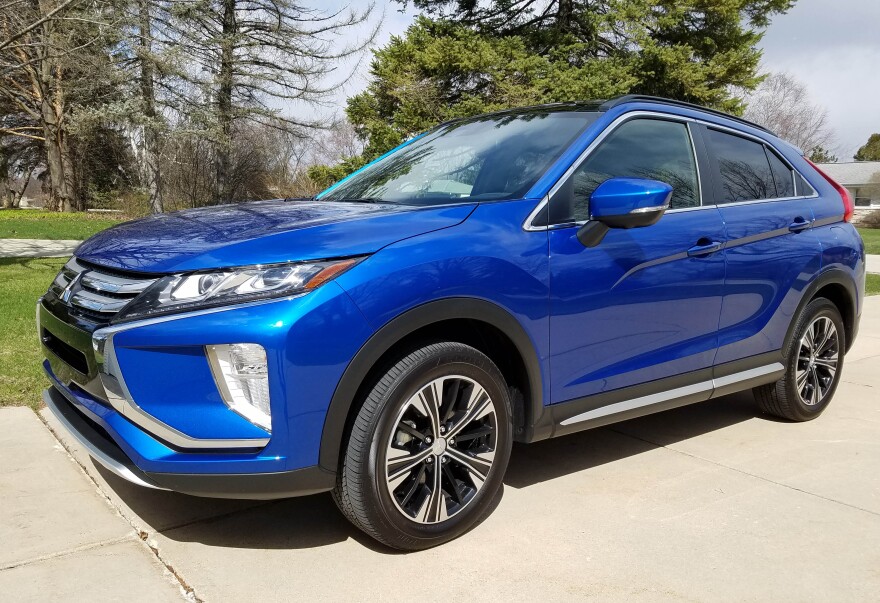A quick history lesson on Mitsubishi for new and younger buyers. The Japanese car maker, most famous for making the nimble Zero aircraft during World War II, used to have a small, but fairly full vehicle lineup.
But tough times and a shrinking, aging lineup hurt Mitsubishi in the early 2000s. Its biggest claim to fame and popularity was its sporty Eclipse, but then even that went away as Mitsubishi began to claw back into the market by offering small SUVs. Last year it sold 121,000 vehicles a 2.5% gain over 2018 and its third year of 100,000+ sales and seventh year of growth.
READ: 2020 Mitsubishi Outlander Sport 2.4GT AWC Review
Compare that with say, Mazda, another of the smaller Japanese car makers, which had 2019 sales of 278,000, with a full product line. Mitsubishi’s best-seller is its mid-size Outlander SUV. So last year it introduced the Eclipse Cross, a compact crossover, obviously hoping the Eclipse name would deliver a bit of marketing magic.
In its first year, 19,600 of the small crossover were sold, and was expected to grow this year, before the coronavirus pandemic socked it to all new vehicle sales.
I drove the Eclipse Cross SEL, its top trim level, but you’d not think that from the price tag. Fully equipped the bright metallic blue test vehicle listed at $32,125. This is a value-oriented crossover that doesn’t look like one, inside or out.

Eclipse Cross features a stylish nose and profile with clever rear styling that makes it look fast and sporty. It’s neither, but your neighbors don’t know that. The styling’s downside becomes apparent from the rear. It has a funky looking tail end. Looking at it straight on, it resembles the old Pontiac Aztek. That’s not a compliment.
But let’s stick with the winning side and front styling and the Mitsubishi’s good-looking interior. It neither looks nor feels like a low-cost leader. The SEL comes with leather seating, black here, a textured black dash, soft leather door armrests, and black gloss console with matte silver trim. The center stack is black gloss too with a protruding infotainment screen nicely trimmed in matte chrome.
The screen is average size for entry-level vehicles and easy enough to read. There are some touchscreen functions there, but mostly you need to tune it via a touchpad on the console. I’m not a fan. Other buttons and knobs are well laid out and there’s even a pop-up head-up display standard on SEL. That was a pleasant surprise although the screen that pops up is a bit larger than need be.
Android Auto and Apple CarPlay hookups are standard too, as is an HD radio, push-button start, multi-view backup camera, dual-zone climate control along with heated front seats, and 8-way power driver’s seat. A pretty impressive list for an entry-level crossover. Outside there are fog lights, LED headlights, heated power mirrors, and the test vehicle came with what Mitsubishi calls Super All-Wheel Control or S-AWC. The rest of the auto world calls this all-wheel-drive. However, this version is adjustable for normal roads, plus provides snow and gravel settings, all operated by a button on the console. Nice!

Which brings us to the performance, summed up in one word -- solid.
The AWD helps, naturally, with traction, but Eclipse Cross handles well too. Steering is light and the crossover is easy to park and maneuver. I ran it over some twisty roads and while no sports car it was pleasant.
Power is on the low side, its 1.5-liter turbo I4 churning out just 152 horses, but being a turbo it’s strong on torque at 184 lb.-ft. There’s a bit of low-speed engine noise, but it quickly calms down and is quiet most of the time, especially at highway speeds. The CVT operates smoothly too and gives the powertrain a quality feel.
Ride? Well, that’s pretty bumpy, not helped by Wisconsin roads. But big creases and potholes were felt more than in most cars or crossovers. The Honda CR-V crossover I drove a couple weeks back has a much more refined ride, for example. The Honda also is longer by 10 inches, but rides on a slightly shorter wheelbase. Longer wheelbases usually help smooth ride, but not so much here.

Some safety equipment also is standard, that multi-view camera, for instance, plus blind-spot warning, rear cross-traffic alert, automatic high beams, and forward collision mitigation with pedestrian detection. The test crossover adds a $2,100 Touring Package that includes smart cruise control, auto-dimming rearview mirror with Homelink and high-speed braking activated via forward collision mitigation for safety.
The package also adds roof rails for hauling, dual sunroofs, the front being powered, plus heated rear seats and steering wheel and a rockin’ Rockford Fosgate premium sound system.
Overhead is a Homelink system and SOS emergency call system, unexpected features at this price point. There also are two plugs for phone chargers or other electronic paraphernalia.
I found the vehicle roomy enough for four adults and those rear seats are heated thanks to the option package. Plus there’s plenty of cargo space behind the split fold-down rear seats. One economy move, the hatch is not powered, but that’s OK, it was easy to lift and lower.
As mentioned earlier that hatch is a bit unusual looking with a divided rear window. A few other vehicles (Prius for example) have had this in the past 10 years and while it may enlarge your rear view it looks a bit odd and you see way more following cars’ lights behind you at night, a possible distraction.

Front seats, in addition to being heated, are quite comfortable with good contouring for back and hip support. These were much nicer than I’d imagined they’d be considering the Eclipse Cross’s pricing. The driver’s seat is powered too, but with no adjustable lumbar support, while the passenger’s seat is manually operated.
I also wished there was a radio volume knob other than the buttons on the steering wheel hub, or you could futz with the touchscreen. But hey, you get used to such things after a few weeks in a car.
I was also a little surprised the fuel mileage wasn’t a tad better. I’d gotten 28.6 mpg with the CR-V a few weeks ago but got 26.3 mpg here in about 70% highway driving. And the EPA rates the Mitsubishi at 25 mpg city and 26 mpg highway. It’s rare the highway figure isn’t 3-5 mpg better than the city figure.
Yet at this price you can afford, literally, a little more gas. The tested SEL lists at $29,690 with delivery and as mentioned earlier settled at $32,125 with the Touring package, plus carpeted floor mats and a cargo cover. Average cost of such a vehicle these days is between $35,000 and $36,000.
Even better news, a base front-drive ES starts at $24,335 and you add $1,600 for AWD in any trim level. Plus, Mitsubishi includes a 10-year, 100,000-mile powertrain warranty, a 7-year, 100,000-mile corrosion warranty, and 5-year, 60,000-mile new vehicle limited warranty. So operational costs should be low for quite a while.
While Eclipse Cross is not a name that easily rolls off the tongue, it’s a solid choice if you’re looking for a low-cost and distinctively styled small crossover.
Overview: 2020 Mitsubishi Eclipse Cross SEL S-AWC
Hits: Sharp profile, good handling, AWD, OK power delivery, dual sunroofs, heated front and rear seats and steering wheel, power driver’s seat, contoured seats, good back seat room. Pricing!
Misses: Bumpy ride, low-speed engine noise, touchpad for tuning radio, radio volume only adjusts on wheel and screen, no power hatch, no adjustable driver lumbar support. Funky looking tail end.
Made In: Okazaki, Japan
Engine: 1.5-liter turbo I4, 152 horsepower
Transmission: CVT automatic
Weight: 3,516 lbs.
Length: 173.4 in.
Wheelbase: 105.1 in.
Cargo: 48.9 cu.ft.
Tow: 1,500 lbs.
MPG: 25/26, 26.3 (tested)
Base Price: $29,690 (includes delivery)
Invoice: $29,282
Major Options: Touring package, $2,100
Cargo cover, $190
Carpeted floor mats, $145
Test Vehicle: $32,125
Sources: Mitsubishi, Kelley Blue Book
Editor's note: Mark Savage's auto review column, Savage On Wheels, looks at a new vehicle every week and tells consumers what’s good, what’s not so good, and how the vehicle fits into the marketplace.







